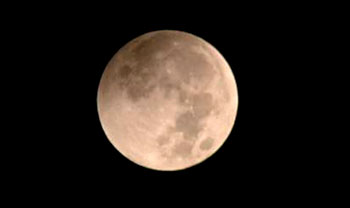Once in a blue moon
Significance of the two full moons in May:
by Lakmal Welabada
We had two Full Moon Poya Days last month, May 1, and 31. The Full
Moon Day which fell on May 1 was declared the Vesak Full Moon Poya and
May 31 was named 'Adhi Poya'. The result of this was that question was
raised whether the Vesak celebration was done on the right Poya day.
 "Vesak means not merely a religious celebration as it has got rooted
into the culture of the nation. Even nature turns in to a more elegant
form during this period of the year," highlights Piyasena Rathuwithana,
leading astrologer and the Consultant Editor of 'Subasetha'. "The trees
bear fruits and flowers bloom everywhere. Birds are seen on the trees
singing happily. "Vesak means not merely a religious celebration as it has got rooted
into the culture of the nation. Even nature turns in to a more elegant
form during this period of the year," highlights Piyasena Rathuwithana,
leading astrologer and the Consultant Editor of 'Subasetha'. "The trees
bear fruits and flowers bloom everywhere. Birds are seen on the trees
singing happily.
The rain keeps the environment cooler than on other days. More than
anything else there are particular flowers that bloom during the month
of Vesak in the Sripada area. All these changes I personally experienced
around me in mother nature during the later days of last month (May),
more than at the beginning of the month," he explains.
Something wrong somewhere! "According to the studies I have done in
astrology, the Vesak Full Moon Poya Day of this year fell on May 31 and
not on May 1," he declares.
"We decide Full Moon Poya Days on the Sri Lankan calendar after
consulting the 'Poya Committee' appointed by the government consisting
about ten persons including astrologers and Buddhist priests," says
Buddhika Warnakula, Public Management Assistant of the Ministry of
Public Administration and Home Affairs.
"When the decisions are made all the high officials of the relevant
Ministries and departments including either or representatives of the
Registrar General should be present. In the beginning of each year, this
committee met to decide the relevant Poya Days of the following year.
Even the next year's Poya Days have already been decided. This was
done in the month of March, And by now it was already gazetted as well,"
he says. Dr. Chandana Jayaratne of the Physics Department, Science
Faculty of the University of Colombo describes the scientific aspect of
the Full Moon Days. "There are two methods (calculations) used to form
the calendar of a year - the Solar and the Lunar. According to the Solar
method, 30 or 31 days is considered a month.
So there are 335 days in a year in this way. Generally the whole
world follows this calendar, so for the convenience we also follow it.
In the Lunar Calendar, 28 days are considered as a month. And 280 days
are considered as a year. These 28 days are counted from one Full Moon
Day to the other. That means in every 28 days time, the moon shines as a
full circle in the sky, and the astrological calculations are also
formed to match this," he explains.
"Though we follow the Solar Calendar we include the Lunar Full Moon
Poya Days too into it, in order to treat the religious countenance, as
we, the Buddhists consider it as a day for our religious activities. So
in every 28 days time a Full Moon Poya falls. When you divide 365 by 28
, there is a balance of 13. This 13 days get collected in two - three
years time, and give (form) an extra month in the following year.
And it adds an extra Full Moon Poya Day as well. This Poya, we call
the 'Adhi Poya'. Especially when a Full Moon Poya falls at the beginning
of a month, another Full Moon Poya Day tends to fall at the end of the
month, after 28 days time forming an 'Adhi Poya'," says Dr. Jayaratne.
Dr. Jayaratne further says that scientifically an 'Adhi Poya' does
not have much effect on the earth as it is considered as just another
Full Moon Day...
"Astrologically too there's no special impact or effect on human
beings by an 'Adhi Poya'," says Manjula Peiris, a young leading
astrologer.
'Shudhassa Ve Sada Phakgu
Shudhassubosatho Sada'
"The person who follows the path of Dhamma while being clean and pure
in his thoughts, deeds and words considers every day as a 'Poya Day'. He
or she does not wait until the Full Moon Poya Day to fall to observe the
five precepts or eight precepts of Dhamma," says Thrikunamalaye Ananda
Thero, the Chief Bhikku of the Siri Vajiragnana Dharmayathanaya,
Maharagama.
"Early years, before the invasion of the Europeans, Sri Lanka had
four Poya Day holidays per month according to the four 'Kala' of the
moon (shapes or appearances of the moon - e.g. the crescent, half and
full moon etc) by going along with the Lunar Calendar. But the Europeans
changed this system and introduced Saturdays and Sundays as holidays.
And through the great endeavour that the then Mahanayaka Theras and
Buddhist scholars could legalise the Full Moon Poya holidays for the
Buddhists.
I take this opportunity to appeal to all the other communities of
this country to respect the Full Moon Poya Day as the Buddhist religious
day without causing any disturbance to them. The Sinhala Buddhists have
been a very tolerant community who simply condone invasions looking at
everything through the tranquillizing mind of Buddhist teachings,"
appeals the Thera.
Ananda Thera further says that since both the Poyas have it is has no
use of arguing about it now. "Let us hope the authorities would not
repeat the same mistake in the future," concludes the Thera.
[email protected] |
